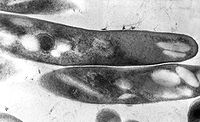
Photo from wikipedia
ABSTRACT American foulbrood is a quarantine disease of the honeybee Apis mellifera L. in many countries and contributes greatly to colony losses. We performed a label-free proteomics study of exoprotein… Click to show full abstract
ABSTRACT American foulbrood is a quarantine disease of the honeybee Apis mellifera L. in many countries and contributes greatly to colony losses. We performed a label-free proteomics study of exoprotein fractions produced in vitro by Paenibacillus larvae reference strains of the ERIC I–IV genotypes. A quantitative comparison was performed of previous studied protein-based virulence factors and many newly identified putative virulence factors. Among the multiple proteases identified, key virulence factors included the microbial collagenase ColA and immune inhibitor A (InhA, an analog of the Bacillus thuringiensis protein InhA). Both of these virulence factors were detected in ERICs II–IV but were absent from ERIC I. Furthermore, the different S-layer proteins and polysaccharide deacetylases prevailed in ERICs II–IV. Thus, the expression patterns of these virulence factors corresponded with the different speeds at which honeybee larvae are known to be killed by ERICs II–IV compared to ERIC I. In addition, putative novel toxin-like proteins were identified, including vegetative insecticidal protein Vip1, a mosquitocidal toxin, and epsilon-toxin type B, which exhibit similarity to homologs present in Bacillus thuringiensis or Lysinibacillus sphaericus. Furthermore, a putative bacteriocin similar to Lactococcin 972 was identified in all assayed genotypes. It appears that P. larvae shares virulence factors similar to those of the Bacillus cereus group. Overall, the results provide novel information regarding P. larvae virulence potential, and a comprehensive exoprotein comparison of all four ERICs was performed for the first time. The identification of novel virulence factors can explain differences in the virulence of isolates.
Journal Title: Virulence
Year Published: 2019
Link to full text (if available)
Share on Social Media: Sign Up to like & get
recommendations!